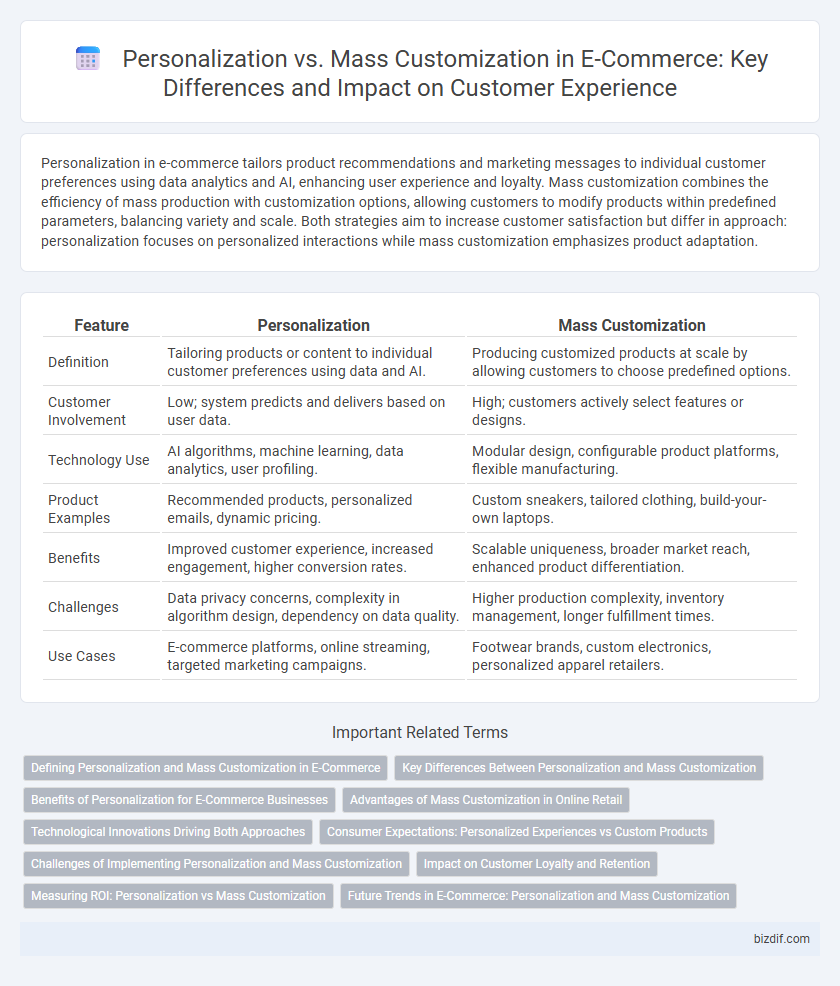Personalization in e-commerce tailors product recommendations and marketing messages to individual customer preferences using data analytics and AI, enhancing user experience and loyalty. Mass customization combines the efficiency of mass production with customization options, allowing customers to modify products within predefined parameters, balancing variety and scale. Both strategies aim to increase customer satisfaction but differ in approach: personalization focuses on personalized interactions while mass customization emphasizes product adaptation.
Table of Comparison
| Feature | Personalization | Mass Customization |
|---|---|---|
| Definition | Tailoring products or content to individual customer preferences using data and AI. | Producing customized products at scale by allowing customers to choose predefined options. |
| Customer Involvement | Low; system predicts and delivers based on user data. | High; customers actively select features or designs. |
| Technology Use | AI algorithms, machine learning, data analytics, user profiling. | Modular design, configurable product platforms, flexible manufacturing. |
| Product Examples | Recommended products, personalized emails, dynamic pricing. | Custom sneakers, tailored clothing, build-your-own laptops. |
| Benefits | Improved customer experience, increased engagement, higher conversion rates. | Scalable uniqueness, broader market reach, enhanced product differentiation. |
| Challenges | Data privacy concerns, complexity in algorithm design, dependency on data quality. | Higher production complexity, inventory management, longer fulfillment times. |
| Use Cases | E-commerce platforms, online streaming, targeted marketing campaigns. | Footwear brands, custom electronics, personalized apparel retailers. |
Defining Personalization and Mass Customization in E-Commerce
Personalization in e-commerce involves tailoring product recommendations, content, and shopping experiences based on individual customer data such as browsing history, purchase behavior, and preferences. Mass customization combines the efficiency of mass production with the flexibility to allow customers to configure products according to specific features, options, or design elements. Both strategies aim to enhance customer satisfaction and increase conversion rates by delivering more relevant and unique shopping experiences.
Key Differences Between Personalization and Mass Customization
Personalization in e-commerce tailors product recommendations and shopping experiences using customer data and behavior patterns, creating unique interactions for each individual. Mass customization allows customers to select specific product features or designs from predefined options, blending personalized choices with scalable production methods. Key differences include personalization relying heavily on data-driven algorithms for individual targeting, while mass customization emphasizes user-driven selection within manufactured possibilities.
Benefits of Personalization for E-Commerce Businesses
Personalization in e-commerce enhances customer experience by delivering tailored product recommendations and targeted offers based on individual browsing and purchasing behaviors, increasing conversion rates. Leveraging data analytics and AI-driven tools allows businesses to predict customer preferences, fostering loyalty and repeat purchases. Personalization also reduces cart abandonment and boosts average order value, directly impacting revenue growth.
Advantages of Mass Customization in Online Retail
Mass customization in online retail enables businesses to offer tailored products at scale, enhancing customer satisfaction by meeting individual preferences without the high costs of traditional customization. This approach leverages advanced technologies like AI and 3D printing to streamline production processes, reduce inventory waste, and accelerate delivery times. By providing personalized experiences through mass customization, retailers can increase customer loyalty and differentiate themselves in a competitive e-commerce landscape.
Technological Innovations Driving Both Approaches
Technological innovations such as artificial intelligence, machine learning, and big data analytics power both personalization and mass customization in e-commerce by enabling precise consumer behavior analysis and product recommendation. Advanced manufacturing technologies like 3D printing and automated assembly lines facilitate scalable mass customization, allowing tailored products to be produced efficiently. Cloud computing and IoT integration further enhance these approaches by supporting real-time data processing and dynamic inventory management.
Consumer Expectations: Personalized Experiences vs Custom Products
Consumers expect personalized experiences that tailor content, recommendations, and communication to individual preferences, enhancing engagement and satisfaction. In contrast, mass customization meets the demand for unique, customizable products, allowing buyers to influence features while benefiting from scalable production. Balancing personalized digital interactions with customizable product options drives higher conversion rates and fosters long-term customer loyalty in e-commerce.
Challenges of Implementing Personalization and Mass Customization
Implementing personalization in e-commerce faces challenges such as data privacy concerns, the complexity of integrating AI algorithms for accurate customer insights, and the high costs of maintaining real-time personalization engines. Mass customization struggles with supply chain flexibility, increased production costs due to bespoke manufacturing, and difficulties in managing inventory while meeting diverse customer specifications. Both approaches require robust data infrastructure and advanced analytics to balance scalability with individualized customer experiences.
Impact on Customer Loyalty and Retention
Personalization in e-commerce leverages consumer data to tailor product recommendations and shopping experiences, significantly boosting customer loyalty by creating a sense of individual recognition and relevance. Mass customization, offering consumers the ability to modify products on a broader scale, enhances retention by meeting diverse preferences without compromising operational efficiency. Both strategies increase repeat purchases, but personalization drives deeper emotional connections, while mass customization appeals through unique, customer-driven products.
Measuring ROI: Personalization vs Mass Customization
Measuring ROI in e-commerce personalization involves analyzing customer engagement, conversion rates, and average order value, which typically show significant improvement due to tailored shopping experiences. Mass customization ROI measurement focuses on production costs, order volume, and customer satisfaction linked to unique product configurations, often reflecting higher margins but increased operational complexity. Comparing both approaches, personalization drives scalability and repeat purchases, while mass customization enhances brand loyalty through exclusive offerings, requiring distinct metrics to accurately assess financial impact.
Future Trends in E-Commerce: Personalization and Mass Customization
Future trends in e-commerce emphasize the integration of AI-driven personalization and scalable mass customization to enhance customer experience and increase conversion rates. Advanced machine learning algorithms analyze vast datasets to deliver tailored product recommendations, while flexible manufacturing technologies enable on-demand production of personalized goods. The convergence of these approaches is transforming digital retail by combining individualized shopping experiences with efficient, customizable supply chains.
Personalization vs Mass Customization Infographic

 bizdif.com
bizdif.com